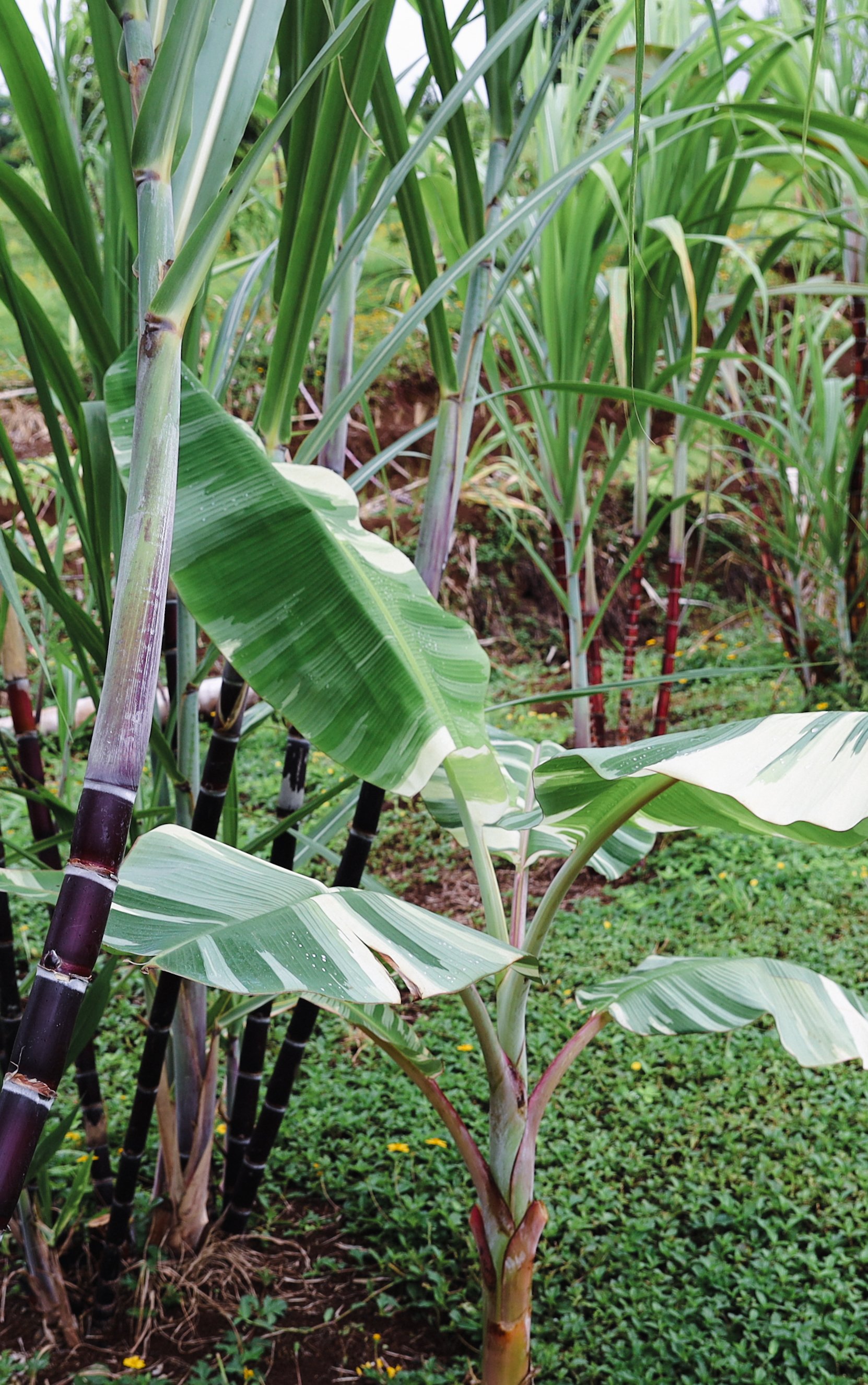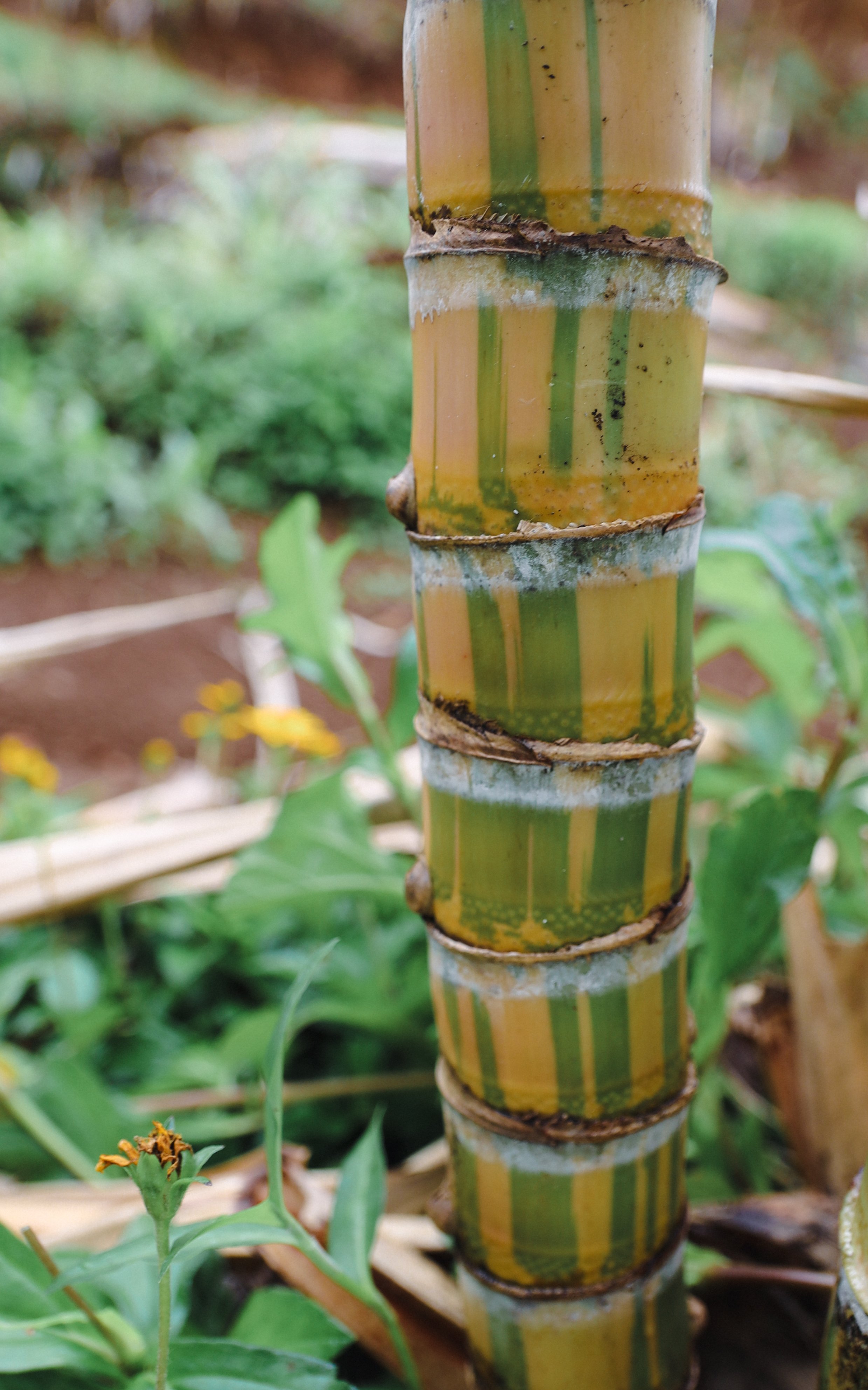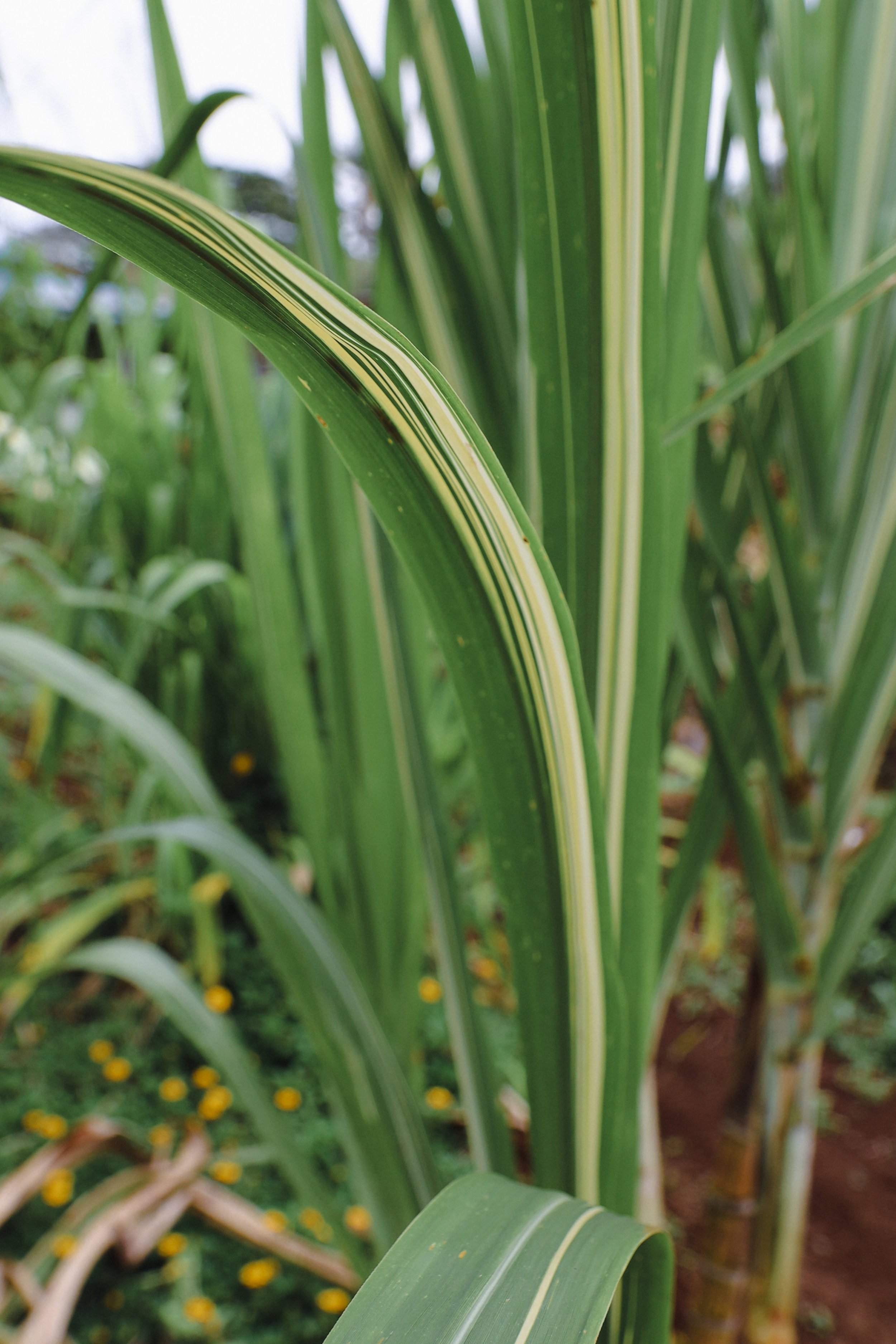𑁍
Kō (sugarcane) is a nutrient-dense perennial grass that flourishes in tropical conditions with minimal care.
Kō was one of the canoe plants brought by the first Polynesians to settle the Hawaiian Islands. Sugarcane juice nourishes the body with antioxidants, minerals, and electrolytes and enhances liver, kidney, and digestive health. In addition to its high nutritional value, kō adds immense beauty to a tropical foodscape.
It grows in a variety of gorgeous colors — from deep velvety purple to yellow with lime green and strawberry pink striations!
Honua’ula kō
Honua’ula literally means “red [‘ula] earth [honua], referring to red soil. This cane is associated with the district on Maui of the same name. The arid region has a deep-reddish soil and swirling winds that caused red dust clouds to swirl about, reportedly reminiscent of how the leaves of ‘Honua’ula’ blowing in the wind caused a reddish glare. Both its stalks and leaves display vibrant deep purple hues. Its brown flesh is very sweet, though not incredibly juicy. It has superb ornamental value in a tropical foodscape.
(Lincoln, N. (2020). Kō: An Ethnobotanical Guide to Hawaiian Sugarcane Cultivars.)
Moano kō
The name “Moano” literally refers to a pale red color and figuratively means “to bloom” but is most often used to denote the red goatfish (Parupeneus multifasciatus) whose red color, so a fable told, was caused by the fish eating the lehua flowers of the ʻŌhiʻa tree. Moano is a vigorous grower with excellent juice.
Mahai’ula kō
A native Hawaiian cane variety whose name literally translates to “red trevally (Pseudocaranx or Gnathanodon spp.), which is said to be rare giant trevally with a reddish hue to its reflection. Its stalks are reddish purple, with sparse dark purple striping. Its sheaths are lightly variegated with white. Mahai’ula produces many delicious, thick, and semi-erect stalks.
Not Laukona kō
Not Laukona is a native Hawaiian cane whose stalk color ranges from beautiful Granny Smith apple green to yellow with sun exposure, with stripes turning from reddish purple to maroon.
Halāli’i kō
A native Hawaiian variety that was famous for growing in Halāli’i, a location on Ni’iahu Island. As a play on words, the name can suggest “little [li’i] Pandanus tree [Hala]. This pun refers to the cane growing in sandy areas of Ni’ihau, where the blowing wind would bury the stalks and leave only the protruding tops visible, reminiscent of a baby Hala tree. (Lincoln, N. (2020). Kō: An Ethnobotanical Guide to Hawaiian Sugarcane Cultivars.)
The stalk often appears three-colored, with a yellow background that flushes easily to pink and striped with translucent green. The leaves are consistently, but weakly, variegated with white. Very sweet flesh. Does not tassel freely.
Laukona kō
A beautiful cane with heavily variegated leaves. Its stalks are pale yellow or striped with green. Laukona produces many stalks that grow densely together. Its very juicy flesh is brown or orangish and is moderately sweet.
𑁍
Sugarcane has been cultivated for thousands of years and is one of the oldest crops known to humankind. It has a rich history that dates back to ancient times.
Kō stalks are filled with sucrose, the source of its sweetness. On average, sugarcane contains about 10-20% sucrose by weight. Under ideal conditions, it can reach its full height in 12 to 24 months.
Sugarcane is not only used for sugar production. Its fibrous residue, called bagasse, is used as a biofuel and in the production of paper, board, and building materials. Molasses, a byproduct of sugar refining, finds applications in the production of rum, ethanol, and animal feed.
FAQs
Which kō variety offers the sweetest and tastiest juice?
While I genuinely appreciate all sugarcane varieties, my personal favorite is pua'ole kō. Its name, meaning "without flower" in Hawaiian, signifies its unique trait of being flowerless. This distinct characteristic contributes to its remarkable growth and exceptional sweetness, as the cane channels all its energy into the sugary stalk.
What is the ideal elevation for kō cultivation?
Kō thrives best near sea level in Hawai'i, but it can grow well up to approximately 2,500 feet.
Do I need to replant kō after it flowers?
A kō clump can endure for decades, but the crop weakens with each passing year. The initial crop yields the fattest and sweetest growth. Successive crops, known as ratoon crops, produce more stalks that mature quickly but gradually become smaller and less sugary. Therefore, it is advisable to replant kō every 5 to 12 years.
What is the best high-altitude kō variety?
Pua'ole thrives remarkably well at high altitudes. Additionally, I highly recommend the vigorous varieties Moano, Big Ribbon, and ‘Uahiapele.
When is the most optimal time to plant kō?
Kō planting follows two schedules: seasonal planting based on the local rainy season and specific lunar dates.
Seasonal planting aligns with the onset of the rainy season, ensuring the young plant receives ample water for optimal growth. Recommended months for planting are 'Iki'iki, Ka'aona (May, June, July), and 'Ikuwa, Welehu (September, November, and December).
Regarding lunar dates, the night of Akua (the 14th day, first full moon) promotes significant stalk and leaf growth. Additionally, the three days dedicated to Kanaloa known as Kaloa (the 24th, 25th, and 26th days, waning quarter moon) are exceptional for sugarcane. During this time, the plants develop long joints, exhibit exceptional sweetness, and possess high-quality medicinal properties. Muku (the 30th day, new moon) also benefits sugarcane cultivation.
Where did the ancient Hawaiians cultivate kō?
Ancient Hawaiians cultivated kō using diverse methods suited to different growing climates. Kō thrived along flooded terraces, providing stability to banks and cooling shade to water. Meticulous care was given to backyard gardens, extensive hedges were formed in rainfed systems, and excavated pits supported growth on young lava flows. Sugarcane adapted to boggy lowlands and even brackish waters.
Which varieties should I plant?
Each cultivar thrives in different environmental conditions. By planting multiple varieties, you create a safeguard against weather variability. Additionally, cultivars display varying degrees of disease and pest resistance. A diverse planting strategy reduces the risk of devastating outbreaks. The more diversity, the stronger the system. Lastly, each cultivar follows its own maturity and ratooning patterns. Planting multiple varieties extends the harvest season and minimizes the need for replanting.
What spacing should I use for kō planting?
Clumps of sugarcane are best planted 2-3m apart, allowing individual management to obtain the sweetest cane possible. This spacing optimizes sunlight penetration, enhances water cycling, and increases sugar content. If planting sugarcane for windbreak or privacy screening, you can space sprouted cuttings approximately 2ft apart.
How tall and wide does kō grow?
Kō clumps can reach heights of 6 to 20 feet (1.8 to 6 meters) and have a width of 3 to 6 feet (0.9 to 1.8 meters). However, actual sizes may vary depending on the variety, growing conditions, and cultivation practices.
What resources do you recommend to learn more about kō?
The sugarcane bible — Noa Keluewa Lincoln’s book KŌ: AN ETHNOBOTANICAL GUIDE TO HAWAIIAN SUGARCANE CULTIVARS
https://uhpress.hawaii.edu/title/ko-an-ethnobotanical-guide-to-hawaiian-sugarcane-cultivars/ (https://uhpress.hawaii.edu/title/ko-an-ethnobotanical-guide-to-hawaiian-sugarcane-cultivars/)











